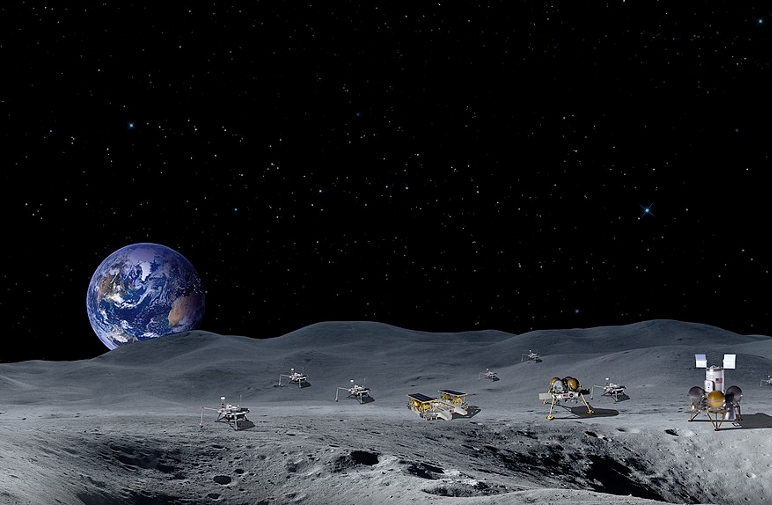Asia Times tells us that there is a “secret mining war” taking place in space over helium-3, a version of helium which is surprisingly abundant on the Moon. Helium-3 is an isotope of helium with two protons and one neutron. The far more prevalent arrangement is helium-4, two protons and two neutrons.
(For those only vaguely familiar with the periodic table, helium is an element which therefore cannot be manufactured from other other elements and must be harvested from nature.*)
The fascination with helium-3 is as a fuel for fusion reactors. This fuel, it turns out, would produce absolutely no radioactive waste—unlike hydrogen-fueled fusion reactors which produce pesky neutrons that bombard components of the reactor and render them radioactive.
So, let’s get this straight. There is supposedly a “secret mining war” between China, the United States and possibly Russia over potential resources on the Moon, resources that might provide very clean fuel for fusion reactors of which there are zero of the commercial variety. And, the number of commercial fusion reactors is likely to stay at zero until at least mid-century. And, there is no assurance that the type of reactor that could use helium-3—which would require much higher temperatures than the hydrogen-fueled ones being contemplated now—will be commercially available any time soon after mid-century.
Some of the challenges of building such a helium-3 friendly reactor are detailed in this piece. Keep in mind that hydrogen is wildly abundant on the Earth in the form of water. Even the far scarcer isotope of hydrogen, deuterium—which is used in current fusion experiments—is much easier to obtain than helium-3 on the Moon and is commercially available today.
I’m not saying it isn’t possible to get helium-3 or other resources from the Moon. Clearly, humans can retrieve things from the Moon as they have already during missions by humans and probes. It is the cost of doing so which ought to warn us that such schemes are unlikely to succeed.
We have examples of similar challenges right here on Earth. There is somewhere between 45,000 and 1.5 million tons of gold in the Earth’s oceans. But the gold is so diffuse that the cost of extracting it is far above the price of gold.
Likewise, the cost of bringing helium-3 from the Moon would be colossal for reasons of distance and low concentration. Concentrations are believed to be around 20 to 30 parts per billion in the lunar soil called “regolith.” That implies that a huge amount of lunar surface would have to harvested and processed to extract an amount worth transporting. Yes, we might improve our technology over time and make it less costly to do this. But keep in mind that the technology for extracting the alternative, deuterium, will likely improve as well, allowing it to keep its competitive advantage.
The obsession with mining the Moon strikes me as the kind of fantasy that enters into civilizations when they are faced with huge, seemingly insurmountable problems—climate change and resource depletion come to mind—and they want magical solutions that allow them to forego having actually to face those problems.
In the Asia Times story linked at the beginning of this piece, scientists claim that helium-3 is so energy dense as a fusion fuel that “two fully-loaded Space Shuttle cargo bay’s worth of helium-3—about 40 tonnes worth of the gas—could power the United States for a year at the current rate of energy consumption.” A Chinese researcher opines that “the Moon is ‘so rich’ in helium-3, that this could ‘solve humanity’s energy demand for around 10,000 years at least.'”
We humans can produce fusion reactions here on Earth—just not ones that give us surplus energy to use in our society. Humans can bring materials back from the Moon—just not in any quantities that would justify the expense.
We as a society seem to comfort ourselves with the idea that technology will overcome these “small” problems just in time to save us from an energy-deprived future. That belief is likely the worst product of narratives that tell us we can import key things that we might lack on Earth from the faraway reaches of space.
P. S. To read my previous pieces on helium supplies here on Earth, see here, here and here.
*Helium is produced by the decay of radioactive substances, but this process happens at such a slow rate that commercial quantities could not be economically harvested. Particle accelerators and some nuclear reactors also create helium but the amounts are so small and the energy cost so high that these sources are impractical for commercial purposes.
Image: Lunar Gateway – Human Lunar Lander Development (2018). NASA via Wikimedia Commons https://commons.wikimedia.org/wiki/File:Lunar_Gateway_-_Human_Lunar_Lander_Development.jpg
“Under the requested funding for Advanced Cislunar and Surface Capabilities (ACSC), along with other Exploration Campaign activities, NASA will re-establish U.S. preeminence to, around, and on the Moon.”






